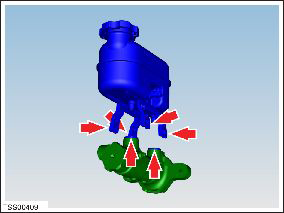Tesla Model S: Master Cylinder (Remove and Replace)
Tesla Model S (2012-2026) Service Manual / Brakes / Master Cylinder (Remove and Replace)
Note: This procedure applies to vehicles with the vacuum brake booster only. If the vehicle has the electromechanical brake booster assembly, the master cylinder is part of the brake booster assembly. Refer to procedure 33031402 (refer to procedure).
Removal
- Remove master cylinder and reservoir assembly (refer to procedure)
- Release reservoir to master cylinder fixing lugs (x4).
- Release reservoir from master cylinder connections (x2) and remove. Note: Place suitable absorbent material around the affected area to absorb any possible fluid spillage.
-
Remove and discard seals (x2) from master
cylinder.
Caution: Replace master cylinder seals.

- Installation procedure reverse of removal, except for the following: Warning: Only use cleaning agents and solvents in a well-ventilated area. Note: Clean the affected areas before installation.
- Bleed brakes (refer to procedure)
READ NEXT:
 Brake Hose - Flexible - Front - LH (Remove and Replace)
Brake Hose - Flexible - Front - LH (Remove and Replace)
Warning: If the vehicle
has air suspension, activate "Jack" mode on the touchscreen before
raising and supporting the vehicle.
Removal
Remove the front LH wheel
(refer
 Brake Hose - Flexible - Rear - LH (Remove and Replace)
Brake Hose - Flexible - Rear - LH (Remove and Replace)
Warning: If the vehicle
has air suspension, activate "Jack" mode on the touchscreen before
raising and supporting the vehicle.
Removal
Remove the rear wheel arch liner
 Bleed Procedure - One Caliper (Remove and Replace)
Bleed Procedure - One Caliper (Remove and Replace)
Warning:
If the 12V power supply is disconnected, do not attempt to open
any doors with door glass in closed position. Failure to follow
this instruction could result in door glass shat
SEE MORE:
 Interior Emergency Release
Interior Emergency Release
An illuminated interior release button inside the front
trunk allows a person locked inside to get out.
Press the interior release button to open the front trunk,
then push up on the hood.
NOTE: The interior release button glows following a brief
exposure to ambient light.
WARNING: People shou
 Cannot charge - Charge handle temperature high
Cannot charge - Charge handle temperature high
Check charge handle or charge port for debris
Charging has been interrupted because the Mobile Connector has detected a
high temperature in the charge handle
that connects to your vehicle's charge port.
Make sure the Mobile Connector is fully inserted into your vehicle's charge port
inlet.
You
© 2019-2026 Copyright www.tesms.org

